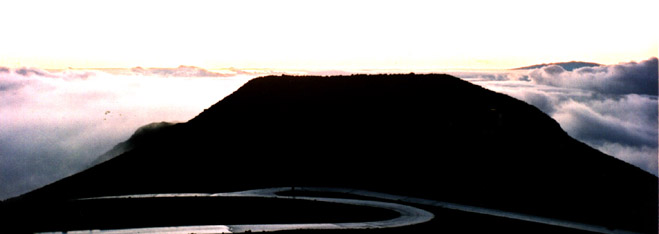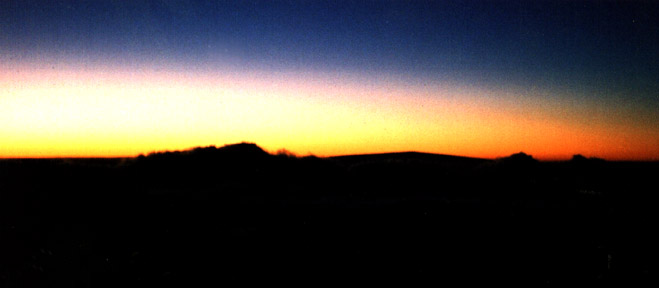This Solstice my husband and I
shared a spiritual experience at the House of the Sun.
Since the Winter Solstice is called "The Return of the
Sun", it seemed an appropriate place at this particular
time. It is the longest night and the shortest day of the
year, and from this point on, the sun will shine longer,
bringing warmth and light, and lengthening the days till
Summer Solstice.
We are currently living on Maui, where
there is not that much difference between winter and
summer. However, we are from Western New York, where the
difference is much more drastic. So we have a tradition
of celebrating the cusp of the year on the
Solstice.
We figured the place to do it was the
ten thousand foot volcanic crater of Haleakala. It is the
physical and spiritual Heart of Maui, and is world famous
for it's sunrises. We moved here in August, but had not
yet braved awakening at 3 AM to drive two hours to the
summit.
In the Hour of the Wolf on December
21st, we got up in the darkness and began the ascent to
the summit. The drive becomes a twisting adventure
through the dark as the jackknifing switchbacks take you
up 10,000 feet in the shortest distance of any road in
the world. Soon it is not only dark but cloudy. Most of
the road has no barriers so any miscalculation would be a
serious mistake. The temperature dropped as we climbed,
from a balmy nighttime 70 degrees in South Maui to a
wintry 35 degrees at the top.
We arrived near the summit an hour
before dawn, and before the crowd. At the lower base camp
there were several adventuresome bikers in parkas ready
to coast down the mountain when the sun arose. A park
ranger in a four-wheel drive SUV told us that the clouds
were closing in and that he was about to close the road
up to the summit. We left the restrooms and heated
observatory behind, and headed up the last segment of
pavement to get to the top.
In less than a mile the road forked.
Scientists go left, tourists go right. The scientists
would be heading to what's called Science City; a cluster
of high tech observatories that are only outdone by the
observatories up top of Mauna Kea, nearby on the Big
Island. Hawaii is Earth's connecting point to the rest of
the Universe.
The summit of Mauna Kea on the Island
of Hawaii hosts the world's largest astronomical
observatory, with telescopes operated by astronomers from
eleven countries. The combined light-gathering power of
the telescopes on Mauna Kea is fifteen times greater than
that of the Palomar telescope in California -- for many
years the world's largest -- and fifty times greater than
that of the Hubble Space Telescope.
We got to the summit and reached the
moon. We picked a spot facing east and set up--two
camping chairs, a thermos of Irish coffee, quiche and
scones for breakfast, two African Ashika drums, cameras
and tripods. The darkness and finger numbing cold would
be the closest thing to winter we would experience this
year, and it seemed fitting that we did on the first day
of the season. At our backs were the white geodesic domes
and polished stainless steel of the
observatories.
As we played our Ashikas in the
darkness, we felt we were "Drumming up the Sun". The sky
slowly blushed with colors before sunrise: purples,
oranges, yellows, rosy reds. The sun finally peeked over
the horizon. Then we saw where we were--above the clouds,
on top of the island with the ocean beyond--on top of the
world!

View from the summit of Haleakela looking east towards
access road
From our vantage point, we could see
the smaller islands of Molokai, Lanai, and Kahoolawe, and
miles of ocean in all directions out to the horizon. All
of Maui lie spread before us, the sloping valley, the
green mountains of the West, towns and beaches. It was a
"God's Eye" view.
One can almost imagine the God Maui,
the "Hawaiian Superman", on this peak when he captured
the sun. Maui was a mischievous god who was a bit of a
trickster. It was he who fished the Hawaiian islands out
of the sea with his trademark fishhook. Hawaiian men
still wear carved fishhooks around their necks to honor
Maui.
According to legend, Maui's mother
Hina was having trouble drying her tapa cloth because the
days were too short. So Maui went up to Haleakala, to ask
the sun to slow its journey across the sky. The sun
refused, so Maui took his fishing line, hooked into the
sun, and lassoed his line around it. He held the sun
until it agreed to slow down and make the days longer.
The mountain became known as the "House of the Sun", and
there are fifteen more minutes of daylight at the summit
than on the coast below.
The summit of Haleakala looks more
like the house of the moon than the "House of the Sun".
The floor of the crater is gray volcanic rock and truly
resembles a moonscape. The only living thing we saw on
the summit was a Silversword, which is a large plant
shaped like a sphere of silvery spikes. It is endangered
and blooms once after seven years, then "pau", the plant
dies.
This sunrise was the most spiritual
experience we have had since we arrived in Maui last
summer. It seems that every time we take the time and
make the effort to commune closely with nature, it is
utterly fantastic and we wonder why we don't do so more
often.
So our advice to you is: watch a
sunrise, a sunset or a moonrise, lay on the ground next
summer during the Perseid meteor showers or just go out
in the evening and look at the stars. Take a camping trip
or just build a campfire in your backyard,. Go hiking,
cross country skiing or swimming in the ocean, a pond or
a lake. Just get out and BE with nature, and you'll be a
happier and better person for it!

